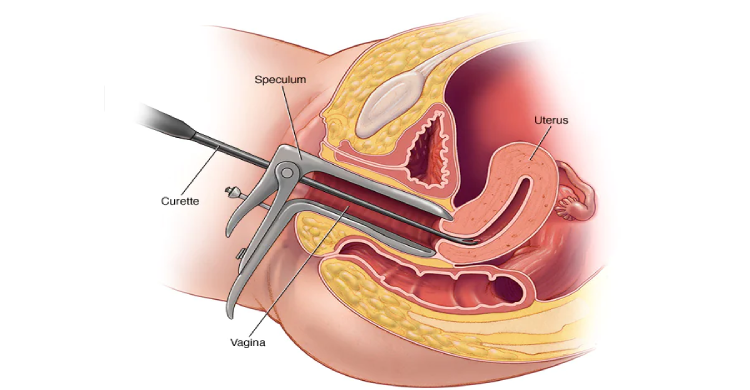Dilation Curettage Treatment
Best Gynecologist for Dilation and Curettage Surgery in Kharghar
Dilation and curettage (D&C) involves dilating the cervix and scraping the uterine lining with a special instrument. Even though the process sounds scary and intimidating, you can combat stress by understanding it. It will be easier for you to relax if you know what to expect before, during, and after a dilation and curettage. By understanding what is happening, you can make the process easier.

What is Dilation and Curettage?
A surgery called Dilation and Curettage (D&C) is used to remove tissue from within the uterus. The lower, thin portion of your uterus is opened (Dilated) during a Dilation and Curettage procedure using tiny tools or a drug. The uterine tissue is then removed by your doctor using a surgical tool called a curette, which can be either a suction device or a cutting instrument. Dilation and curettage are procedures done by medical professionals to identify and treat certain uterine disorders, such as severe bleeding, or to remove the uterine lining following a miscarriage or abortion.
Why it is performed?
The D&C is performed for mainly to diagnose and treat a uterine disorder. It is needed in case of a miscarriage, leftover tissue in your uterus post abortion or unexplained bleeding between menstrual periods. A D&C could be done combined with a Hysteroscopy. A thin tool with a light and camera on the end is inserted into your vagina, via your cervix, and into your uterus during Hysteroscopy. Then, while the lining of your uterus is displayed on a screen, your healthcare practitioner looks for any suspicious areas. Additionally, your doctor collects tissue samples as necessary and looks for polyps. Uterine polyps and fibroid tumours can be removed during a hysteroscopy.
How to prepare for a Dilation and Curettage?
Dilation and Curettage are often performed as outpatient procedures at a hospital, clinic, or your doctor’s office. Prior to the process:
- Limit your intake of meals and liquids as directed by your healthcare practitioner.
- You could feel sleepy after the anaesthetic wears off, so make arrangements for someone to drive you home.
- Give yourself enough time for the surgery and the subsequent healing period.
What happens during a Dilation and Curettage?
A D & C procedure constitute the following steps:
- You will be asked lie on your back on an examination table with your heels supported by supports.
- A Pap test will be taken during which your healthcare professional inserts a device called a speculum into your vagina to view your cervix.
- To gradually dilate your cervix until it is sufficiently open, your doctor inserts a series of rods into it that are progressively thicker.
- Your doctor takes out the dilation rods and inserts a suction device or a spoon-shaped instrument with a sharp edge to remove the uterine tissue.
What is the follow-up care for a Dilation and Curettage?
After a D & C, you may normally go for home in a few hours. For a few days, you may experience some light bleeding or little discomfort. For bleeding, use pads rather than tampons. You ought to be able to resume your normal activities after a week. After the procedure, visit your doctor again a week or two later.
Advantages of a Dilation and Curettage Procedure
Your doctor can determine the cause of your irregular bleeding with the use of a Dilation and Curettage. Additionally, it can aid in the identification of abnormal endometrial cells, which can be a symptom of uterine cancer. Following a D & C, your doctor sends a sample of your cells to a lab so that pathologists can determine if you have cancer, polyps, or normal or abnormal tissue. After a loss or abortion, a D & C may be crucial for your health. Any remaining tissue is removed in order to avoid severe bleeding and infection.
Disadvantages of a Dilation and Curettage Procedure
A D & C is safe but as any other medical procedure it also has its own disadvantages. Some of the risks are uterine perforation, uterine infection, uterine bleeding, cervical damage, scar on the uterine wall, etc.
Consulting hospital
Women's Care Clinic
- C/O Dr. Sonal Bhangale, SHOP NO 512, OPD 209, plot no 47, D Mart Rd, Sector 15, Kharghar, Navi Mumbai, Maharashtra 410210
Alpha One Hospital
- Alphaone Hospital, Kharghar 410210.
